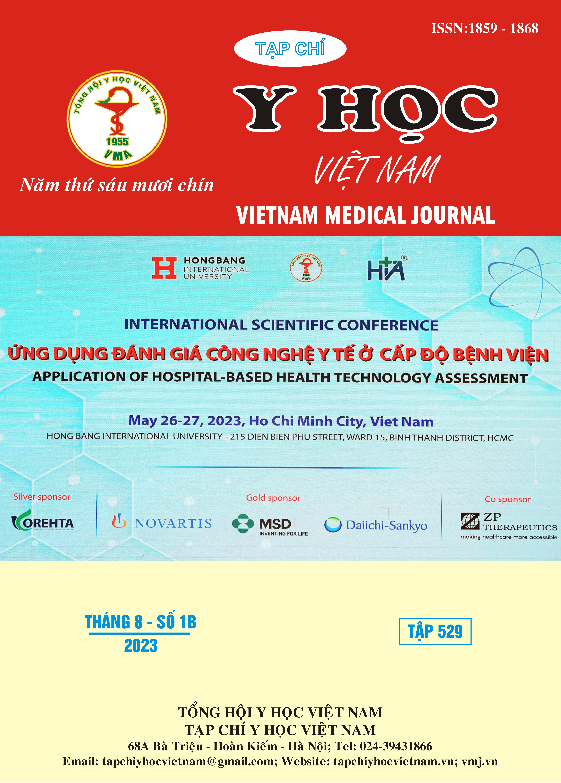ĐÁNH GIÁ KẾT QUẢ PHẪU THUẬT CHỈNH HÌNH HỐ MỔ KHOÉT CHŨM TIỆT CĂN BÍT LẤP HỐ MỔ BẰNG BỘT XƯƠNG TỰ THÂN
Nội dung chính của bài viết
Tóm tắt
Mục tiêu: Đánh giá kết quả phẫu thuật chỉnh hình hố mổ khoét chũm tiệt căn (KCTC) bít lấp hố mổ bằng bột xương tự thân. Đối tượng và phương pháp: Thiết kế nghiên cứu mô tả từng trường hợp có can thiệp, không nhóm chứng, có so sánh trước sau với 22 bệnh nhân sau KCTC được điều trị phẫu thuật chỉnh hình hố mổ tại một số bệnh viện từ tháng 11/2018 đến tháng 3/2023. Kết quả: Trong số 22 trường hợp cho thấy tai khô sau mổ là 20/22 (90,9); màng nhĩ liền có 19/21 ca (86,4%). Biểu bì hoá toàn bộ có 21/22 ca (95,5%). Ngưỡng nghe trung bình (PTA) sau mổ 52,03±30,06dB so với trước mổ 64,69±26,87dB ở nhóm không chỉnh hình xương con (CHXC), và 56,61±15,75db sau mổ so với trước mổ 67,59±20,40 ở nhóm có CHXC và đều thấp hơn so với trước mổ ở tất cả các tần số. Khoảng cách đường khí – đường xương (ABG) trung bình thay đổi rõ ràng ở nhóm có CHXC sau mổ là 24,55±12,43db ở so với trước mổ 38,48±13,50 dB. ABG đều thấp hơn so với trước mổ ở cả 2 nhóm. Kích thước hố mổ theo tỉ lệ Va/S sau mổ nhỏ hơn trước mổ (25,87 so với 47,17). Tỉ lệ tai biến, biến chứng thấp: 1/22 ca bị nhiễm trùng (4,5%) và 1/22 ca (4,5%) có hoại tử, bong vạt da. Kết luận: 6 tháng sau phẫu thuật cho thấy tỷ lệ khô tai sau mổ đạt 20/22 (90,9%), hình thái giải phẫu, các triệu chứng cơ năng được cải thiện. Phẫu thuật không gây suy giảm sức nghe, thậm chí còn phục hồi. Có thể thấy phẫu thuật chỉnh hình hố mổ KCTC bít lấp hố mổ bằng bột xương tự thân là một kỹ thuật đem lại kết quả tốt, thực hiện an toàn, có thể ứng dụng ngay ở lần phẫu thuật đầu tiên hoặc phẫu thuật chỉnh hình lại hố mổ.
Chi tiết bài viết
Từ khóa
chỉnh hình hố mổ khoét chũm tiệt căn, bít lấp hố mổ, bột xương tự thân.
Tài liệu tham khảo
2. V. Singh M. Atlas (2007), "Obliteration of the persistently discharging mastoid cavity using the middle temporal artery flap", Otolaryngol Head Neck Surg. 137(3), 433-8.
3. Nguyễn Tấn Phong (2018), "Xử lý tai biến và di chứng hố mổ tiệt căn xương chũm", Chuyên đề Tai Mũi Họng và Phẫu Thuật Đầu Cổ, Hội Tai Mũi Họng Tp. Hồ Chí Minh, Nhà Xuất Bản Y Học, 118-121.
4. R. P. Mehta J. P. Harris (2006), "Mastoid obliteration", Otolaryngol Clin North Am. 39(6), 1129-42.
5. Phạm Thanh Thế (2017), Nghiên cứu chỉnh hình tai giữa trên hố mổ khoét chũm tiệt căn. Luận án Tiến sĩ Y học, Trường Đại học Y Hà Nội.
6. Nguyễn Hoàng Huy (2018), Đánh giá kết quả chỉnh hình màng nhĩ xương con, đồng thời với phẫu thuật khoét chũm tiệt căn. Luận án Tiến sĩ Y học, Trường Đại học Y Hà Nội.
7. Nguyễn Thị Tố Uyên (2018), Đánh giá kết quả phẫu thuật nội soi tiệt căn xương chũm đường trong ống tai ở bệnh nhân viêm tai giữa mạn tính nguy hiểm. Luận án Tiến sĩ Y học, Trường Đại học Y Hà Nội.


